Ysart Glass Puzzles
Pieces appearing on this page are apparently Monart, Vasart or Strathearn, but they have a puzzling feature. In general be wary of any piece that is described as experimental Monart/Vasart/Strathearn — especially, if it bears a label stating this. A few authentic specials have been identified and can be seen on the Ysart Glass Specials page. Fakers are as likely to try and pass their work off as ‘special’ when it is inconsistent with the genuine article. As a rule of thumb: if a piece seems odd it is best to assume it is not Ysart.
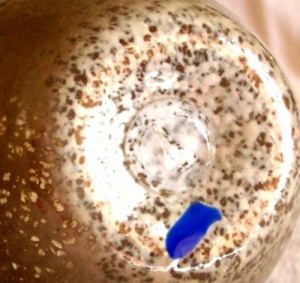
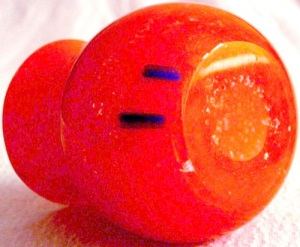
These two pieces were found in a storeroom at the Moncrieff glassworks by director Colin Mayor. One, shape SA, has a single blue rod and the other, shape N, two blue bars, but their purpose is unknown. They are however a good source for discussion, though we shall never know if they ever had a purpose or were mistakes.
Colin thought that they may have been used as masters. Glassmakers use callipers to get the finished size correct and there is a possibility that masters were made for this purpose, the blue rods being marvered in to ensure they were not sold. If they did make masters in this way, then potentially, another 300 different examples should exist. But to date I have not heard of such ‘masters’.
Further discussion with Ian Turner, author of the Monart article in Ysart Glass and various publications, sheds doubt on the “master” piece theory. Ian had many meetings with Paul Ysart and explored the Ysart working practices in depth with him. During those meetings, the use of masters was never mentioned by Paul.
Ian Turner also said “For a start with, not all the Working Samples have blue rods. I have two pieces that came from this store room, and one has a ‘Working Sample’ label. Another appeared at Christie’s June 28 2001 British Decorative Arts sale lot 12: this piece I had seen at Perth in the late 1980s. None of these pieces has a blue rod - which look like mistakes to me!. All these pieces are either unfinished or are sub-standard wares that were unsaleable and kept back. In no way can they be described as ‘Monart’. The probable reason for keeping them is evident from my Working Sample labelled piece because on it is written, in Paul’s hand, “New Green”, which suggests that it was kept to illustrate the colour not the size. If it had been kept for its shape or size it would have said so on the label. In any event, Paul didn’t need a master copy on the shop floor to tell him what shape or size to work to: he had been making these shapes and sizes all his life and knew them instinctively. He did use the callipers, however, to check the sizes.
So, in my view, these ‘Working Samples’ aren’t Monart, aren’t any good, and not worth collecting except in so far as they have an identifiable purpose. I’ll concede, however, that they are of some interest because they sometimes illustrate a colour way or perhaps an experiment which went wrong.”
Ian and Colin both agree that these blue rod pieces and the others that they own are all “Working Samples” from the Moncrieff factory. Ian does not think that they should ever be called ‘Monart’.
My own thoughts are that these were either some sort of experimental pieces made for testing various techniques, including finishing or that they were produced during the training of Vincent and Augustine.
Any other ideas?
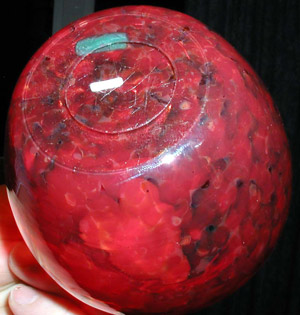
Another example has surfaced, this piece differs in having one turquoise bar and one white bar.
The colouring of the vase is also a little unusual: being a single translucent reddish colour.
Vase is also shape N, like the first one above, which would tend to confirm that these are not shape ‘Working Samples’. The similarity in size of bars on the three vases would also make it unlikely that these were accidental and why do the last two have such well polished bases?
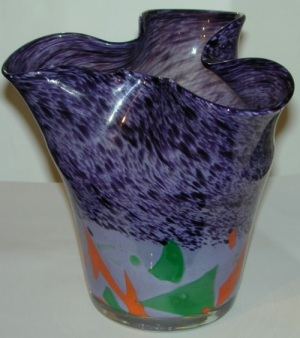
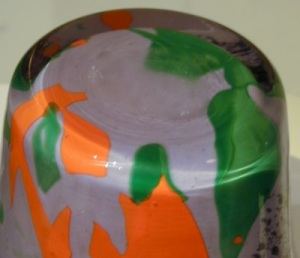
This piece was sold as an experimental Vasart but this just does not work for me. I bought this myself to get a good look.
While the ground colour is passable as Vasart, the orange and green are much too intense. Then the thickness of the outer clear casing is something I have never seen in Vasart. Finally it bears no pontil, with some rough grinding in the centre of the nearly flat base.
While Strathearn is a possibility, it too seems a little unlikely. The most plausible explanation is that this was made recently (circa 2000) in the style of the Vasart/Strathearn - possibly commissioned by an unscrupulous dealer in a deliberate attempt to deceive. The actual seller had little knowledge of this glass style and was probably used to take it to market.
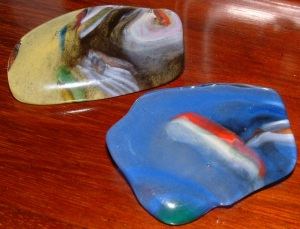
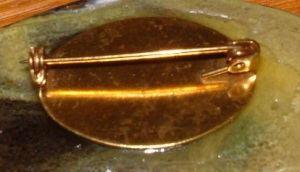
These two brooches look very much like Strathearn glass and glass jewellery of this type was seen in art glass shops since the 70’s. Herbert Dreier is not aware of these having been made during his time there, since 1970, but they could have been made earlier or without his knowledge. In the latter case they may be unique but I would expect more to have been made. Please let us know if you have seen jewellery of this type before and particularly if you can give any help in clarifying when they were made and by whom.
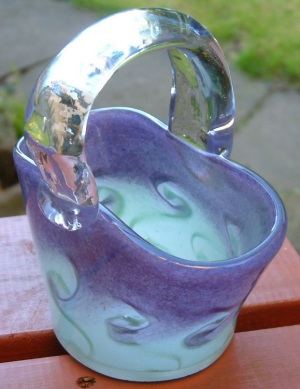
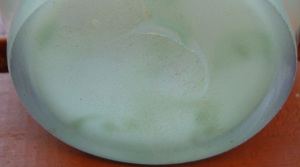
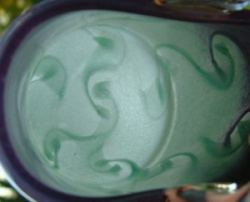
Not sure what to make of this piece but it is unlikely to be Vasart owing to the thickness of the outer casing. However, it is reminiscent of the so-called Vasart experimental piece shown above. Perhaps, this was the same maker? Any suggestions would be welcomed.
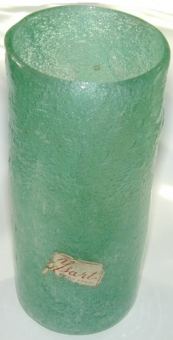
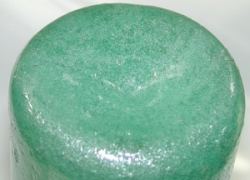
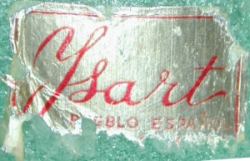
No one can link this to the Ysart’s, originally Isart, who made the glass that is the subject of this website. The label gives me the impression of late 1950’s to 1970’s. The bottom line of text on the label is missing. This piece is 153mm (6") high. The base is pointed inward similar to old bottles. Before the English immigration had their say, the spelling of Ysart was Isart. I bought this piece of glass many years ago and have never been able to track down additional information on the maker. It would be interesting to find out more.
Ivo Haanstra suggested: “The object looks like the simple “pulegoso” glass they still make in Egypt, but the Italians made something very similar before WWII. “El Pueblo Espanol”, of course, is “the Spanish village” - whatever the relevance of that.”
SOLVED OCTOBER 2003 - With thanks to a visitor. Pueblo Espanol is a tourist village in Majorca comprised of reproduction architecture from around the country and enlivened with shops, restaurants and a glass workshop.